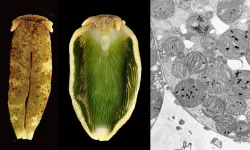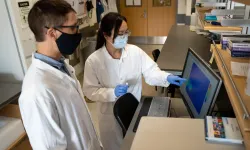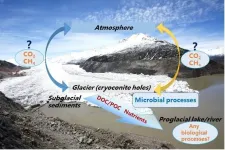What does the sleeping brain think about?
Thanks to a unique system that decodes brain activity during sleep, a UNIGE team is deciphering the neuronal mechanisms of memory consolidation.
2021-07-15
(Press-News.org) We sleep on average one third of our time. But what does the brain do during these long hours? Using an artificial intelligence approach capable of decoding brain activity during sleep, scientists at the University of Geneva (UNIGE), Switzerland, were able to glimpse what we think about when we are asleep. By combining functional magnetic resonance imaging (fMRI) and electroencephalography (EEG), the Geneva team provides unprecedented evidence that the work of sorting out the thousands of pieces of information processed during the day takes place during deep sleep. Indeed, at this time, the brain, which no longer receives external stimuli, can evaluate all of these memories in order to retain only the most useful ones. To do so, it establishes an internal dialogue between its different regions. Moreover, associating a reward with a specific information encourages the brain to memorise it in the long term. These results, to be discovered in the journal Nature Communications, open for the first time a window on the human mind in sleep.
In the absence of tools capable of translating brain activity, the content of our sleeping thoughts remains inaccessible. We however do know that sleep plays a major role in memory consolidation and emotional management: when we sleep, our brain reactivates the memory trace built during the day and helps us to regulate our emotions. "To find out which brain regions are activated during sleep, and to decipher how these regions allow us to consolidate our memory, we developed a decoder capable of deciphering the activity of the brain in deep sleep and what it corresponds to", explains Virginie Sterpenich, a researcher in the laboratory of Professor Sophie Schwartz in the Department of Basic Neurosciences at UNIGE Faculty of Medicine, and the principal investigator of this study. "In particular, we wanted to see to what extent positive emotions play a role in this process."
During deep sleep, the hippocampus - a structure of the temporal lobe which stores temporary traces of recent events - sends back to the cerebral cortex the information it has stored during the day. A dialogue is established which allows the consolidation of memory by replaying the events of the day and therefore reinforce the link between neurons.
Combining MRI, electroencephalography and artificial intelligence
To conduct their experiment, the scientists placed volunteers in an MRI in the early evening and had them play two video games - a face-recognition game similar to 'Guess Who?' and a 3D maze from which the exit must be found. These games were chosen because they activate very different brain regions and are therefore easier to distinguish in the MRI images. In addition, the games were rigged without the volunteers' knowledge so that only one of the two games could be won (half of the volunteers won one and the other half won the second), so that the brain would associate the game won with a positive emotion.
The volunteers then slept in the MRI for one or two hours - the length of a sleep cycle - and their brain activity was recorded again. "We combined EEG, which measures sleep states, and functional MRI, which takes a picture of brain activity every two seconds, and then used a 'neuronal decoder' to determine whether the brain activity observed during the play period reappeared spontaneously during sleep", Sophie Schwartz explains.
Even when asleep, the brain likes rewards
By comparing MRI scans of the waking and sleeping phases, the scientists observed that during deep sleep, the brain activation patterns were very similar to those recorded during the gaming phase. "And, very clearly, the brain relived the game won and not the game lost by reactivating the regions used during wakefulness. As soon as you go to sleep, the brain activity changes. Gradually, our volunteers started to 'think' about both games again, and then almost exclusively about the game they won when they went into deep sleep", says Virginie Sterpenich.
Two days later, the volunteers performed a memory test: recognising all the faces in the game, on the one hand, and finding the starting point of the maze, on the other. Here again, more the brain regions related to the game were activated during sleep, better were the memory performances. Thus, memory associated to reward is higher when it is spontaneously reactivated during sleep. With this work, the Geneva team opens a new perspective in the study of the sleeping brain and the incredible work it does every night.
INFORMATION:
ELSE PRESS RELEASES FROM THIS DATE:
2021-07-15
The COVID-19 pandemic halted the in-person wintertime survey of wolves and moose on the island for the first time in 63 years. Consequently, there are no estimates of wolf or moose abundance for 2021, and the next estimates are scheduled in February 2022. But though the Isle Royale Winter Study didn't happen quite as planned, researchers were still able to visit the remote national park in the spring.
Now, fieldwork has resumed and Michigan Technological University researchers have already uncovered new information about these two iconic wildlife populations. In particular, wolves produced at least two litters of pups, and moose appear poised for decline.
In the Isle Royale Winter Study, Michigan ...
2021-07-15
Plants, algae and some bacteria are able to perform photosynthesis, which is the process of transforming sunlight energy into sugar. Animals are generally unable to use this process to acquire energy, but there are a few known exceptions to this. Some sea slugs take up chloroplasts from the algae that they consume into their cells. These chloroplasts retain their ability to perform photosynthetic activity within the animal cells for several months, and thus provide them with photosynthesis-derived nutrition. This process is called "kleptoplasty", and it has attracted much attention due to its amazing uniqueness in making animals photosynthetic for over 50 years.
A pressing question is how these sequestered chloroplasts retains their photosynthetic capability without algal nuclei. ...
2021-07-15
Since the Paris Climate Agreement that took effect in 2016, 121 countries have pledged to become carbon neutral by 2050 as the world tries to reduce its fuel consumption. The Korean government also unveiled its 2050 Carbon Neutral Strategy on December 7, 2020 and declared Carbon Zero, making transition to new and renewable energy a topic of conversation. Recently, a joint research team from POSTECH and Korea University has developed a radiative cooling material that can reduce energy consumption by selectively reflecting or transmitting sunlight.
A research team led by Professor Junsuk Rho, Ph.D. candidate Minkyung Kim, and Dr. Dasol Lee of POSTECH's departments of mechanical engineering and chemical engineering, and a team led by Professor Heon Lee and Soomin of the Department of Materials ...
2021-07-15
Combined perceptions of the risk and availability of cannabis influence the risk of cannabis use more than perceived risk and perceived availability alone, according to a new study at Columbia University Mailman School of Public Health. Researchers observed that those who perceived cannabis as low-risk and available were more likely to report using the drug in the past year and almost daily compared to those individuals who perceived cannabis as high-risk and unavailable. This is the first study to consider the joint effects of perceived risk and perceived availability. The results are published in the journal Drug and Alcohol Dependence.
"Our study described the evolution of joint perceptions of cannabis risk and availability from 2002-2018 and estimated the relationship between combined ...
2021-07-15
Adolescent girls and young women can and will use HIV prevention products with consistency, according to interim results of a study of two different methods: daily use of the antiretroviral (ARV) tablet Truvada® as oral pre-exposure prophylaxis (PrEP) and the monthly END ...
2021-07-15
Shining a beam of light into potentially contaminated water samples may hold the key to real-time detection of hydrocarbons and pesticides in water.
UBC Okanagan researchers are testing the use of fluorescence to monitor water quality. The results, they say, show great promise.
When a beam of light is shone into the water, it excites the electrons in molecules of certain compounds and causes them to emit light. The characteristics of the emitted light are like a fingerprint and can be used to identify certain contaminants, explains Nicolas Peleato, an assistant professor at UBCO's School of Engineering.
"The challenge with using this fluorescence approach is that ...
2021-07-15
Repairing complex electrical appliances is time consuming and rarely cost-effective. The working group led by Prof. Dr. Karl Mandel, Professorship of Inorganic Chemistry at Friedrich-Alexander-Universität Erlangen-Nürnberg (FAU), has now developed a smart microparticle that enables defective components in these appliances to be identified more quickly and easily by using light signals. In the long-term, this could make repairs easier and extend the operating life of devices. The results have been published in the journal Advanced Functional Materials.
To identify defective components in a device, particles known as supraparticles are applied to the individual parts. These particles measure between one and ten micrometres and under black light they provide information ...
2021-07-15
Fukuoka, Japan--At this very moment, the billions of neurons in your brain are using their trillions of connections to enable you to read and comprehend this sentence.
Now, by studying the neurons involved in the sense of smell, researchers from Kyushu University's Faculty of Medical Sciences report a new mechanism behind the biomolecular bonsai that selectively strengthens these connections.
How neuronal circuits remodel themselves over time, especially during early development, is an open question in neurobiology. At the start of neuronal development, neurons form excessive amounts of connections ...
2021-07-15
The cryosphere, a term used to describe the areas of the Earth's surface where water exists in solid form, plays an important role in regulating the Earth's climate. Due to cryospheric retreat; for example, the melting Greenland ice sheet in the Arctic, greenhouse gases that were formerly in "frozen storage" are now being released. High Mountain Asia, also known as the Tibetan Plateau, hosts the largest volume of glaciers outside the polar regions. However, Tibetan glaciers are currently excluded from global greenhouse gas budgets.
According to Shichang Kang, leader of a group of researchers who recently became the first team to measure the flux variations of greenhouse gases (CO2 and CH4) in typical glacial basins in High Mountain Asia, it's important that Tibetan glaciers are not ...
2021-07-15
New research will help doctors identify, treat and prevent potentially dangerous irregular heartbeats in patients with hypertrophic cardiomyopathy (HCM), a common heart condition in which the heart thickens and strains to pump blood.
These chaotic heart rhythms are known as atrial fibrillation. Atrial fibrillation can be asymptomatic, but it can lead to blood clots, stroke or even heart failure. The new research, from an international team of doctors and scientists, identifies risk factors for major atrial fibrillation outcomes, such as the need for procedures or hospitalization for more than 24 ...
LAST 30 PRESS RELEASES:
[Press-News.org] What does the sleeping brain think about?
Thanks to a unique system that decodes brain activity during sleep, a UNIGE team is deciphering the neuronal mechanisms of memory consolidation.






